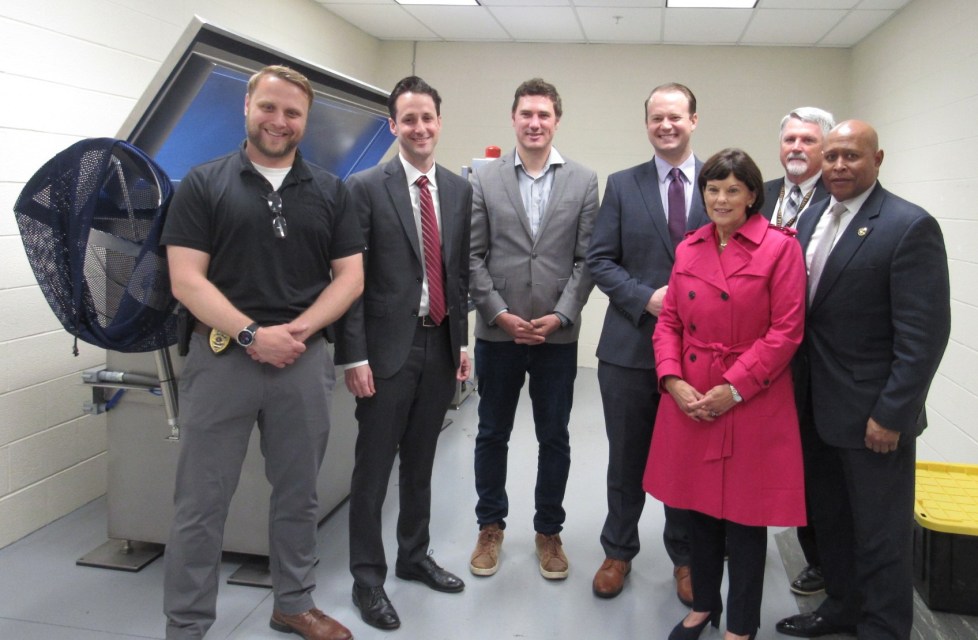‘Ballistic Tank’ will aid Chester County police in firearms cases

WEST CHESTER — Picture this: A gunfight erupts in downtown West Chester on a weekend evening, with multiple shots fired in front of the Historic Chester County Courthouse. Police investigators find numerous bullet casings and projectiles, as well as more than one weapon. Lots of people are involved.
But where did the bullets come from? Which gun matches which projectile? Are all the bullets from the same gun, or different ones? Who gets charged, and with what?
In the past, it could take six months to a year to get those answers, as the state police Crime Lab worked the evidence. Now, Chester County Detectives will be able to get the information they seek much faster within days.
On Wednesday, the Chester County District Attorney’s Office and the Chester County Detectives announced that they had fully implemented Ballistics Tank technology into the investigative process of firearm identification. The “tank” — located in the basement of the Chester County Justice Center — will allow firearms recovered by police here to be tested almost immediately by a Chester County Detectives firearms examiner.
This is the final piece of equipment funded by a state grant, supported by an application by the Chester County commissioners.
In a release about the new equipment, District Attorney Chris de Barrena-Sarobe said, “Giving law enforcement timely access to the latest technologies is critical to fighting gun violence. When used in conjunction with the existing (National Integrated Ballistics Information Network) program, this Ballistics Tank will give law enforcement leads that will solve crimes and stop cycles of violence that sometimes emerge in our community.”
In the release, Commissioners Josh Maxwell, Marian Moskowitz, and Eric Roe noted, “Everyone dedicated to law enforcement in Chester County — from the DA’s Office staff and our County Detectives to all municipal detectives and officers — deserves to have the latest technology that supports speed and precision in solving crimes. It is why we approved funding through the American Rescue Plan Act for rapid DNA technology, and it is why we support this important equipment to strengthen ballistics evidence.”
When a gun is fired, it typically leaves a unique tool mark on the bullet and any fired cartridge casings (commonly referred to as an “FCC” or shell casing). Thus, a firearms examiner uses a ballistic tank to safely test-fire firearms not just for operability, but to also use the test-fired bullets and casings to conduct microscopic comparisons of ballistic evidence recovered from a crime scene.
According to the D.A.’s Office, there are large benefits of having a firearms examiner in-house.
These benefits include the ability to potentially determine the types of firearms at a crime scene that will provide investigators direction for their investigations, determine the number of firearms that were used at a crime scene, the ability to link ballistics evidence at a crime scene to a firearm much faster than previous methods, and the ability to enter evidence from a crime scene into a national data much quicker, which in turn will link the crime scene to other crime scenes where that firearm was used and link a firearm once recovered.
The Ballistics Tank is essentially a large water tank. When a gun is test-fired into the tank, friction from the bullet passing through the water slows the bullets down and eventually allows the bullet to sink to the bottom of the tank, thereby creating a pristine sample that can be compared to evidence from crime scenes.
The sample bullets and fired cartridge casings are then entered into the NIBIN database. There, a computer program is used to compare the tool markings to images of submitted ballistic evidence from shooting scenes across the country with the recovered firearms.
Any potential matches are then reviewed by a firearms examiner and immediately shared with investigators from those jurisdictions.
The District Attorney’s Office has joined with Bucks County, Delaware County, and Montgomery County to obtain NIBIN status this past year, which was funded through a federal high-intensity drug area grant program.
“Crime does not know municipal and county lines,” de Barrena-Sarobe said. “We are already using this technology to link crime scenes and follow up on possible illegal gun purchases. This is a pivotal tool for law enforcement.”
The Pennsylvania Commission on Crime and Delinquency grant that funded this project totaled $450,000. It includes roughly $60,000 for the Ballistics Tank, with the balance of the grant funding already spent on personnel and other equipment.
To contact staff writer Michael P. Rellahan call 610-696-1544.
View more on Mainline Media News